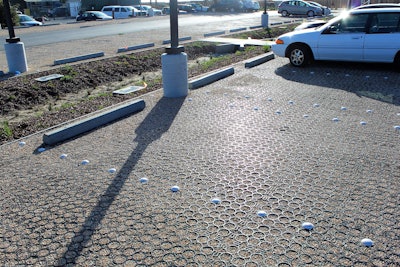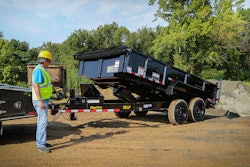 Photo: TRUEGRID
Photo: TRUEGRIDAcross the country, permeable, or porous, pavement is gaining popularity over traditional paving solutions like concrete and non-porous asphalt.
Permeable pavement is comprised of a combination of interlocking grids that are laid over a prepared subsurface. The grids are filled with one of several fill materials, such as gravel, crushed limestone, or grass. This results in a strong, durable and low-maintenance surface.
The global permeable pavement market size is estimated to grow from $2.13 billion in 2015 to $22.17 billion by 2026, at a compound annual growth rate of 5.7 percent. Market growth can be attributed to the thriving construction industry and increased demand for solutions related to stormwater management.
In addition to environmental benefits, porous paving can help project managers lower material, labor, equipment, maintenance, and long-term operational costs. However, landscapers may have questions about the practicalities of permeable pavement solutions.
To what extent does permeable pavement improve water quality?
Water-absorbing soil and vegetation is lost when natural groundcover is replaced with impervious surfaces like parking lots and streets. Increased runoff from impervious surfaces causes dangerous floods, severe erosion damage to stream channels, diminished recharge of groundwater, and degraded habitat for fisheries.
These same impervious surfaces can transport and deposit pollutants in urban areas such as sediment, bacteria, pesticides and chloride. In the worst cases, the amount of pollutants in urban runoff are high enough to prevent residents from being able to swim or fish in local waters.
Efforts to reduce the impacts of urban runoff are a focus for environmental legislators at the local, state and federal levels. Permeable pavers cut down on storm runoff that can collect motor oil and other pollutants, overburdening water treatment facilities and sometimes ending up in local water sources.
The Environmental Protection Agency recognizes the sustainability advantages of permeable pavers and acknowledges that they can also help reduce flooding of building foundations and ponding on driveways, sidewalks and patios.
How do permeable pavements reduce costs?
Installing permeable pavement usually costs significantly less than concrete, and although they are cost competitive to asphalt paving systems, permeable pavers don’t require the expensive drainage systems or significant long-term maintenance that asphalt does.
Asphalt surfaces are soft, crack easily, and develop potholes in hot weather, especially as they age, and sealant begins to degrade. As a result, maintaining asphalt requires periodic surface damage repairs and re-sealing. Concrete surfaces are also prone to cracking and require regular re-sealing, especially in cold climates. Repairing cracks in concrete requires damaged areas to be removed and re-poured.
Both concrete and asphalt systems have drainage systems that must be cleared periodically to avoid clogs and inspected for faulty pipes and damaged drains. This ongoing maintenance significantly increases long-term costs of concrete and asphalt systems.
Between the grids and the fill material, the cost of materials of permeable systems tends to be far less than concrete and similar to asphalt. Additionally, because the fill materials are acquired locally, shipping costs are greatly reduced compared to the price of transporting asphalt or concrete materials to the site. Because permeable pavement requires less extensive draining systems, it reduces construction costs for commercial and residential projects.
Do permeable pavements last as long as traditional pavements?
Permeable pavers create a strong, durable surface with a similar lifespan to concrete and asphalt surfaces. Because the surface is flexible and porous, and the fill materials are secured by interlocking grids, permeable pavers do not crack or break like concrete and asphalt solutions. Permeable pavement solutions perform better overall in warm and cold weather and reduce the need for road salt.
Permeable pavement can clog with sediment and pollutants. How can this issue be avoided?
Permeable plastic grid pavers with no fabric attached to the grid are best and will remain 100 percent permeable for years and years when filled with clean aggregate. ASTM infiltration tests on the plastic grid systems that had been in use in heavily trafficked commercial parking lots for 3 to 5 years showed infiltration rates of over 1,000 inches per hour, with no maintenance during that period. Pervious concrete and asphalt do not perform as well and must be cleaned with an industrial vacuum every 3 to 6 months to maintain porosity. This is due to the small pore size that easily clogs with sediment.
What should landscapers consider when choosing a permeable paving solution?
Permeable pavers are a cost-effective, low-maintenance alternative to concrete and asphalt surfaces due to their lightweight, porous design, made from recycled plastic and locally sourced fill materials. There are a variety of options in the permeable paver marketplace.
Technology has provided new options beyond the grass ribbon driveway with paved strips for the tires. The most popular formats are concrete interlocking pavers, recycled plastic grid systems, pervious concrete, and porous asphalt.
When evaluating permeable paving solutions, decision makers should look for a trusted supplier with a reliable inventory source and a product that can be customized for each project’s needs.
TRUEGRID offers paving solutions for residential, commercial and industrial needs made from 100 percent post-consumer recycled HDPE. With completely pervious cover and 1,000 inches per hour infiltration rate, TRUEGRID Permeable Pavers provide stormwater storage and improved detention in all climates and soils. Learn more at https://www.truegridpaver.com/.
EDITOR’S NOTE: This article was written by Christopher White. White is a senior sales engineer with TRUEGRID Pavers. He has designed permeable paving and drainage systems for a variety of industrial, commercial, and residential projects. His prior experience also includes analysis, review and support for pipeline and offshore technology installations. He holds two degrees in civil engineering: a Bachelor of Science and a Master of Engineering, both from Texas A&M University.










